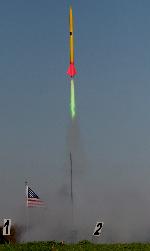Red Glare XI
November 2011
/ Higgs Farm
2 flights, 12000 N-sec burned
Due to a late harvest, Red Glare XI was pushed into mid-November from its usual mid-October date, making it possible for me to attend the famous biannual launch. As usual, Todd picked me up from the airport when my flight landed; I had given my Competitor 4 to Wildman at Midwest Power a few weeks prior, so all we had to do was head to the field. We were greeted by three days of low ground winds and clear skies -- unfortunately, the upper level winds had different plans, making for some tough recoveries. After flying wrapped up on Friday night, we grabbed dinner with Jerry O'Sullivan and talked all things rockets. Attending the banquet on Saturday night was a unique experience. Sunday's flying was limited by the upper level winds and lack of recovery time, but by the time Sean McAndrew and I rolled out from the site and headed for dinner and then the airport, I'd still managed to add 12,000 newton seconds and nearly 30,000 feet to the Competitor's flight log -- definitely a good weekend! Thanks as always to Todd for propellant, Wildman and CJ for transportation services and recovery assistance, Sean for the airport ride and the sparky tips, and Bob Utley for being a master diplomat for sticky recovery situations.
View All Photos
After arriving on Friday morning, I quickly headed over to Wildman's RV to make sure CJ had put my rocket in -- and was gratified to see the yellow-and-pink fin can happily tucked between a pair of Extreme WM kits. I retrieved it and hoofed it back to Todd's SUV to start prepping. Though I hadn't cleaned the 6000 case at Midwest Power, Todd instantly had the old motor apart (having the liner come out in one piece is always helpful) and filled with a new green propellant load. Meanwhile, I worked on getting the avionics package assembled and ejection charges built. Andrew Diehl also showed up with a sweet HD video camera and 3D printed mount, which we promptly bolted to the payload section. My PicPac has been acting up lately, and I elected to leave out the beacon in lieu of a simple BeeLine RDF tracker. Buttoning up the airframe happened shortly thereafter, and we headed to the pads. Neil was on LCO (as always), announced the flight, and called out the count. The green motor was a little slow to pressure up -- likely due to the somewhat undersized igniter - but as the first chartreuse flames licked the blast deflector, the rocket quickly got down to business and roared into the air. The rocket made a fantastic, smooth boost, but after burnout we heard a quiet whistling sound; this would later turn out to be the camera re-entering the launch site after disassembling itself from the mount as the vehicle passed through the sound barrier. The rocket ignored all of this mayhem and continued its planned flight, reaching apogee at just over 14,200 feet and performing a nominal dual deploy recovery. The tracker signal never died (indicating we ended up in the woods), but we managed to quickly locate the rocket hanging just at the edge of Tommy's woods. A quick yank on the shock cord freed the nose cone from the trees, and all was recovered intact, ready for another flight. Awesome green motor - the P should be unreal.
Altitude: 14,228 ft
Since everything came back in one piece, I dragged everything into the hotel room that night to re-prep the bird with a red test load. This was from a bigger batch that included Carb, Nitrate, and Chromate, and ended up making a 10k and a 4 grain O for Ryan's latest project, so we were eager to see how the effect turned out. The propellant was in six shorter segments (versus the usual five) due to casting tube limitations. Other than that, though, everything loaded up as normal. I pulled the camera-less camera mount from the payload section, and buttoned the rocket up early with help from Todd, Andrew, and my old friend Chris Lam. We were to the pads early, but two misfires (one bad igniter, one bad battery) delayed the flight until about 1 PM. Finally, the Competitor boogied into the air on a long red tail, quickly disappearing from sight. We heard the apogee event occur, and a few minutes later the tracking signal disappeared, indicating that it was on the ground somewhere - no trees, yay! I piled into the car with Dan and Kahli Patel to go searching. Even a mile and a half from the site, though, I still had no signal - my thoughts immediately jumped to something having gone wrong. We headed back to the site so I could hop on top of Wildman's motorhome and try and get a beep, but to no avail. Todd and I headed back out and started aimlessly driving the back roads of the eastern shore; as it was getting dark, the receiver suddenly twitched, and then squawked to life as my call sign came blaring through in morse code. It was alive! We quickly acquired two intersecting bands of probability and noted the GPS waypoints from which they were taken; after it got dark, we headed back to the hotel and plotted our likely search area using Google Earth. That night, I talked to Bob Utley and Tommy Higgs to get clearance, and we planned our approach for the next day. At about 10 AM, Bob performed his diplomatic duties most excellently and gained us access to the property; 20 minutes later, Todd and I stumbled onto the rocket in the field, intact, beeping just shy of 15,100'. Quite the recovery adventure, and a new altitude record for this battlehorse!
Altitude: 15,092 ft



